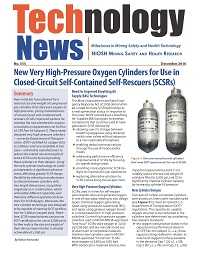Mining Publication: Technology News 555 - New Very High-Pressure Oxygen Cylinders for Use in Closed-Circuit Self-Contained Self-Rescuers (SCSRs)
Original creation date: December 2016
New materials have allowed for a reduced size and weight of compressed gas cylinders that store pure oxygen at high pressures, giving manufacturers of closed-circuit self-contained self-rescuers (SCSRs) improved options for meeting the new standard for oxygen consumption requirements set forth in 42 CFR Part 84 Subpart O. These newly designed very high-pressure cylinders —currently Department of Transportation (DOT)-certified for oxygen duty to 3,000 psi and now available in two sizes—will enable manufacturers to reduce the overall size and weight of future SCSR units by incorporating these cylinders in their designs. Using this new cylinder technology at 3,000 psi represents a significant advancement, affording greater SCSR design flexibility by allowing manufacturers to choose between cylinders with two length dimensions, using them singularly or in combination, which will enable different capacities and therefore different operational durations for SCSR designs. Moreover, the new cylinder technology was designed to be capable of meeting DOT certification for 5,000 psi oxygen duty. Therefore, SCSR manufacturers can pursue DOT certification for use at 5,000 psi to further reduce the size and weight of their devices beyond what is already achievable at 3,000 psi.
Authors: R Fernando
Technology News - December 2016
NIOSHTIC2 Number: 20048987
Pittsburgh, PA: U.S. Department of Health and Human Services, Public Health Service, Centers for Disease Control and Prevention, National Institute for Occupational Safety and Health, DHHS (NIOSH) Publication No. 2017-111, TN 555, 2016 Dec; :1-2
See Also
- 3+3 SCSR Donning Screen Saver - 1.0
- Advances in Mine Emergency Communications
- BG 4 Benching Trainer Software - 1.0.5
- BG 4 Breathing Apparatus Training Software Released
- Cleaning, Disinfecting, and Sterilizing Self-Contained Self-Rescuer Mouthpiece Assemblies Used in Hands-On Training
- Expectations Training for Miners using Self-Contained Self-Rescuers in Escape from Underground Coal Mines
- Interactive BG 4 Training Software Reinforces Skills for Benching Mine Rescue Breathing Apparatus
- Proposal for Certification Tests and Standards for Closed-Circuit Breathing Apparatus
- Self-Contained Self-Rescuer Donning Proficiency at Eight Eastern Underground Coal Mines
- Transfer of Self-Contained Self-Rescuer Donning Skills Under Similar Conditions of Practice: The Draeger OXY-SR60B and the CSE SR-100
- Content source: National Institute for Occupational Safety and Health, Mining Program


 ShareCompartir
ShareCompartir
